Fiddler Crab (Uca tetragonon)

Image: Dave Hinchliffe
Observed: Koh Chang, 2016
Observed By:Dave Hinchliffe
A fiddler crab, sometimes known as a calling crab, may be any of approximately 100 species of semi-terrestrial marine crabs which make up the genus Uca. As members of the family Ocypodidae, fiddler crabs are most closely related to the ghost crabs of the genus Ocypode. This entire group is composed of small crabs – the largest being slightly over two inches across. Fiddler crabs are found along sea beaches and brackish inter-tidal mud flats, lagoons and swamps. Fiddler crabs are most well known for their sexually dimorphic claws; the males’ major claw is much larger than the minor claw while the females’ claws are both the same size.
…and seeing a bunch of them in mating season prancing around and jousting with each other like single males in a village disco is a very entertaining sight.
Fiddler Crab Wikipedia
Slow Worm (Anguis fragilis)
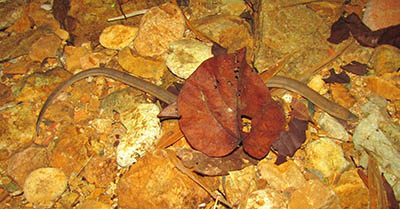
Image Copyright Paul Dunn
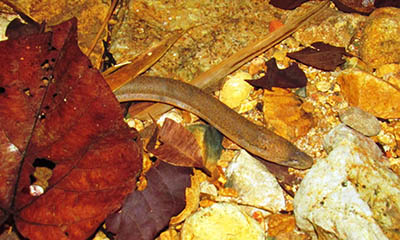
Image Copyright Paul Dunn
Last Observed: December 2015
Observed By: Paul Dunn
OK get ready. The slow worm isn’t actually a worm. And it isn’t a snake. It is actually a lizard without any legs that isn’t a snake. Yes they exist, this is one. Got it?
The Anguis fragilis, or slow worm, is a limbless lizard native to Eurasia. It is sometimes called a blindworm. Its German name, “Blindschleiche”, is derived from the Old High German plintslîcho meaning “blinding creeper”, perhaps because of its lustrous scales.
Slow worms are semifossorial (burrowing) lizards, spending much of the time hiding underneath objects. The skin of slow worms is smooth with scales that do not overlap one another. Like many other lizards, slow worms autotomize, meaning that they have the ability to shed their tails to escape predators. While the tail regrows, it does not reach its original length. They are common in gardens and can be encouraged to enter and help remove pest insects by placing black plastic or a piece of tin on the ground. On warm days, one or more slow worms will often be found underneath these heat collectors. One of the biggest causes of mortality in slow worms in suburban areas is the domestic cat, against which it has no defense.
Slow Worm Wikipedia
Black-Headed Bulbul (Pycnonotus atriceps)
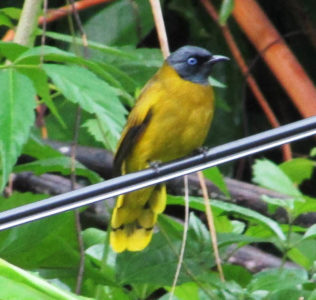
Image Copyright Paul Dunn
Last Observed: December 2016 – Koh Chang
Last Observed By: Paul Dunn
The black-headed bulbul (Pycnonotus atriceps) is a member of the bulbul family of passerine birds. It is found in forests in south-east Asia. It has a mainly olive-yellow plumage with a glossy bluish-black head. A grey morph where most of the olive-yellow is replaced by grey also exists. The distinctive taxon from the Andamans has most of the head olive, and is increasingly treated as a separate species, the Andaman bulbul, (P. fuscoflavescens). The black-headed bulbul resembles the black-crested bulbul, but has blue eyes (though not reliable in juveniles), a broad yellow tip to the tail, and never shows a crest (however, some subspecies of the black-crested are also essentially crestless, but they have red or yellow throats). The black-headed bulbul mainly feeds on small fruit and berries, but will also take insects. It commonly occurs in small flocks, comprising 6-8 individuals.
Don’t confuse the black-headed bulbul, which has a black head, with teh black-crested bulbul, which has a black head and a black crest, or ornithologists will scorn you.
Black-Headed Bulbul Wikipedia
Lesser False Vampire Bat (Megaderma spasma)
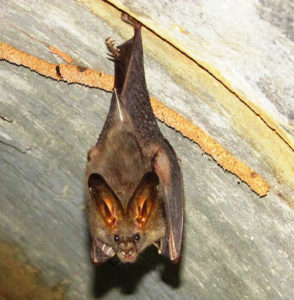
Image Copyright Paul Dunn
Observed: Koh Chang, December 2016
Observed By: Paul Dunn
The lesser false vampire bat (Megaderma spasma) is a bat found in South Asia and Southeast Asia from Sri Lanka and India in the west to Indonesia and the Philippines in the east. They live in caves and tree hollows. They are insectivorous.
The lesser false vampire bat has a wingspan of up to 30 centimetres (12 in) and have a head-and-body length of around 10 centimetres (3.9 in). Their forearms are normally around 7 centimetres (2.8 in).
The lesser false vampire bat has yellowish veins through the wing, and when the wings are spread with light behind, they are given a prominent yellow/orange tinge. Their body colour ranges from grey-brown to blue-brown. Lesser false vampire bats live in rock crevices, caves, foliage and hollow trees, depending on availability, as well as hanging and sleeping on trees in general.(bush-crickets or katydids) found in China, Japan, Nepal, India, Thailand, Singapore and Indonesia.
Lesser False Vampire Bat Wikipedia
Conocephalus melanus
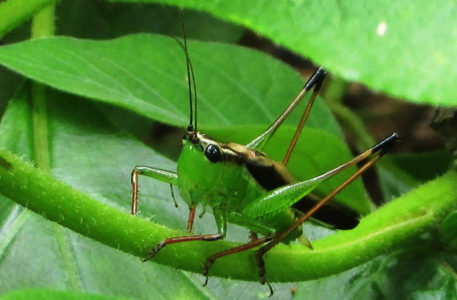
Image Copyright Paul Dunn
Observed: December 2016, Koh Chang
Observed By: Paul Dunn
Conocephalus melanus is a species of Tettigoniidae (bush-crickets or katydids) found in China, Japan, Nepal, India, Thailand, Singapore and Indonesia.
Conocephalus melanus
Black-Capped Kingfisher (Halcyon pileata)
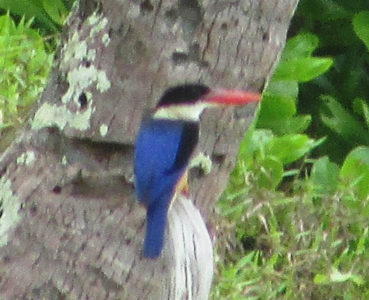
Image Copyright Paul Dunn
Last Observed: December 2016 – Koh Chang
Last Observed By: Paul Dunn
The black-capped kingfisher (Halcyon pileata) is a tree kingfisher which is widely distributed in tropical Asia from India east to China, Korea and Southeast Asia. This most northerly of the Halcyonidae is resident over much of its range, but northern populations are migratory and they wintering south of their range to Sri Lanka, Thailand, Borneo and Java. It is distinctive in having a black cap that contrasts with the whitish throat, purple blue wings and the coral red bill. The species is mainly found in coastal and mangrove habitats but can sometimes be found far inland.
It is a medium sized bird growing up to 28cm in length.
Black-Capped Kingfisher Wikipedia
Orange Oakleaf (Kallima inachus)
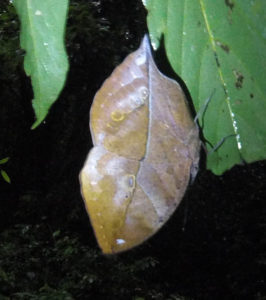
Image Copyright Paul Dunn
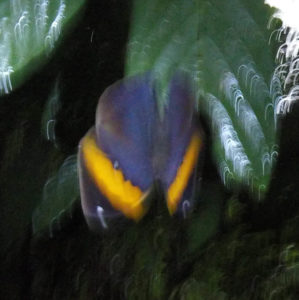
Image Copyright Paul Dunn
Last Observed: December 2016, Koh Chang
Observed By: Paul Dunn
Kallima inachus, the orange oakleaf or dead leaf, is a nymphalid butterfly found in tropical Asia from India to Japan. With wings closed, it closely resembles a dry leaf with dark veins and is a spectacular and commonly cited example of camouflage. It’s also a very rare case where the butterfly looks more interesting with its wings closed rather than open.
Orange Oakleaf at Wikipedia
Tropical Leatherleaf (Laevicaulis alte)
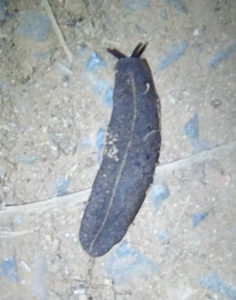
Image Copyright Paul Dunn
Observed: Koh Chang, December 2016
Observed By: Paul Dunn
Koh Chang Nature proudly announces… our first slug identification!!!
The Tropical Leatherleaf, Laevicaulis alte is a round, dark-coloured slug with no shell, 7 or 8 cm long. Its skin is slightly tuberculated. The central keel is beige in colour.
This slug has a unique, very narrow foot; juvenile specimens have a foot 1 mm wide and adult specimens have a foot that is only 4 or 5 mm wide.
The tentacles are small, 2 or 3 mm long, and they are only rarely extended beyond the edge of the mantle.
Tropical Leatherleaf Wikipedia
Great Owl Moth (Erebus macrocops)
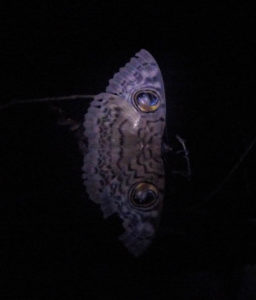
Image Copyright Paul Dunn
Last Observed: December 2016, Koh Chang
Observed By: Paul Dunn
Erebus macrops is a species of moth of the family Erebidae. It is found in the subtropical regions of Africa and Asia. It is a big old moth (the wingspan is about 12 cm) making it exceptionally large for an Erebidae species. The larvae feed on Acacia and Entada species.
Their most notable feature is a large eye-like circlular pattern on each wing.
Great Owl Moth at Wikipedia
Malayan Five Ring (Ypthima horsdieldii)
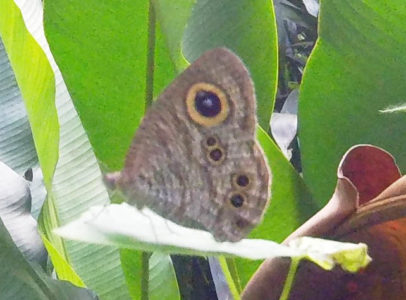
Image Copyright Paul Dunn
Last Observed: January 2016, Koh Chang
Observed By: Paul Dunn
This butterfly, named for the five circles on each wing is a native of peninsular Malaysia and Thailand.
Presumably the eye-like spots are used to confuse predators.
Malayan Five Ring at Butterfly Circle













